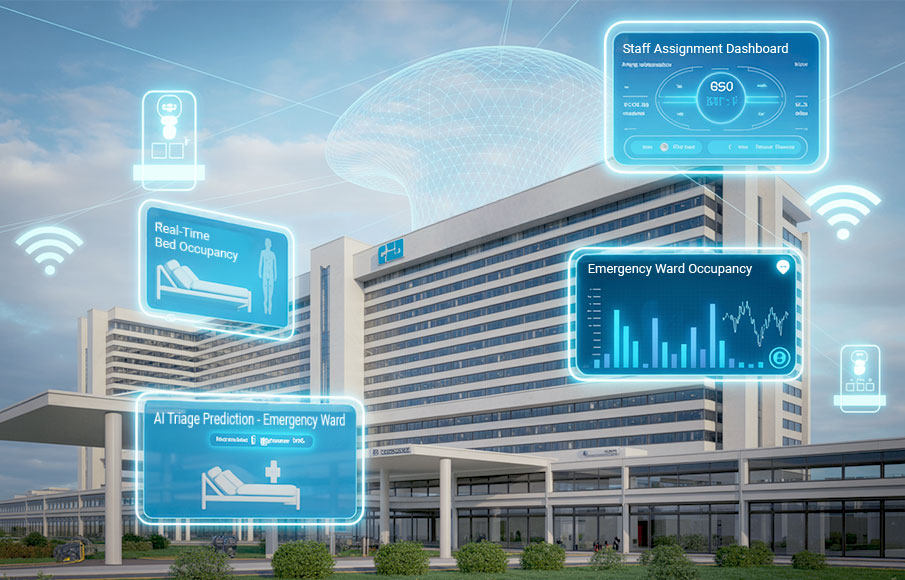How to Reduce & Fix Network Congestion in 2024
- 28 May 2024

Network congestion occurs when a network is overloaded with more data than it can handle, resulting in a reduced quality of service. It can disrupt business operations by causing delays in accessing critical resources and create a poor user experience for customers interacting with your online services.
Congestion can also create vulnerabilities in the network, increasing the risk of data breaches or unauthorised access due to delays in processing security protocols and updates. Ensuring a smooth network flow can enhance operational efficiencies, increase customer satisfaction, and bolster data security.
Causes of Network Traffic Congestion

Data sent over a network is divided into packets. Like rush hour traffic slowing down all road users in a lane, network congestion can happen when too many data packets are sent into a single link or node in a particular network.
Many factors can contribute to congestion, such as poor network infrastructure or misconfigured traffic. To avoid network congestion, it’s essential to identify the causes.
Excessive Bandwidth Consumption
Excessive bandwidth consumption is one of the primary causes of network congestion. Higher bandwidth usage by some network users or devices can lead to network slowdowns and potential outages for everybody on the same network. This can cause data traffic jams and affect other users’ network connections.
Poor Subnet Management
Subnetting helps to streamline data flow, prioritising business-critical traffic and preventing network congestion. However, poor subnet management can slow down data transmission due to improper allocation of network resources and segments. Data can take unnecessary routes, adding unneeded traffic.
Broadcast Storms
Broadcast storms occur when a high volume of broadcast packets congest the network, causing delays and disruptions in data transmission. They can be caused by inadequate network monitoring and management, or hardware failure resulting from the use of cheap hubs and ports.
Multicast
Multicast is mainly used in environments where a large number of users need to receive the same data, such as data streams and graphics displays. As multiple nodes attempt to send data simultaneously, multicast traffic collisions may occur. This can result in packet loss and degraded network performance.
Border Gateway Protocol
Border gateway protocol (BGP) directs network traffic by choosing the best paths for data transmission. However, BGP may not choose the most efficient route available due to factors like congestion and cost. Issues with BGP routing can contribute to inefficient management of data traffic, leading to bottlenecks and slowdowns.
Outdated Hardware
Using outdated hardware such as old switches, routers, and servers can create bottlenecks in data transmission, leading to network congestion and reduced performance.
Professional Solutions to Reduce/Fix Network Congestion
Here are some professional solutions that SPTel offers to resolve these common causes of network congestion:
| Solutions | Features | Benefits |
| Software-Defined Network |
|
|
| Software-Defined Wide Area Network |
. |
|
| Managed Services for Customer Premise Equipment |
|
|
Software-Defined Network
With a Software-Defined Network (SDN), administrators can manage and provision network services virtually. Users are provided with an overview of the network, and have full control of its traffic and configuration.
SPTel’s SDN offers easy configuration of services through an online self-service portal. We allow for provision of resources such as new network connections and bandwidth on-demand provisioned in minutes. This enhances business agility, allowing network administrators to quickly adapt their network in line with their real-time needs. Furthermore, SPTel’s SDN delivers <1ms ultra-low latency performance across the entire network to handle real-time application performance.
SD-WAN
SD-WAN (software-defined wide area network) is an application of SDN that links network devices across distributed locations. It helps large businesses connect their services across multiple sites.
Our SD-WAN services allow for proactive rerouting of network traffic when congestion is detected. We empower businesses to automate and prioritise network traffic using faster, more secure connections. This optimisation of high traffic volume enables near real-time access to rapidly changing data, which is a key benefit crucial for mission-critical applications. If rerouting is still unable to resolve congestion issues, users can leverage SPTel’s Bandwidth on Demand capabilities to request additional bandwidth as needed.
SD-WAN coupled with SPTel’s unique SDN infrastructure also enables users to fully utilise their existing bandwidth by allowing prioritising of traffic usage based on performance requirements. Applications such as video streaming, which require ultra-low latency, can be prioritised more easily and efficiently.
Finally with SPTel’s 2 in 1 SD-WAN solution that comes with Firewall inbuilt, users can manage network congestion as well as cybersecurity all via 1 device for reductions in cost and complexity.
Managed Network Services
Managed Network Services are outsourced IT services and infrastructure management for a network. They help businesses simplify their IT operations. Providers manage your network equipment lifecycle for you and ensure your equipment is optimised and up to date. They can also tailor their services to suit your business needs.
SPTel’s Managed Network Services are able to help you achieve a simplified and optimised network that reduces burden on your team, increasing your operation efficiency.
Explore Our Cost-Effective Network Congestion Solutions

A stable and robust network is essential for any business. SPTel’s Software-Defined Network offers a flexible and scalable network, with reliable customer support and technical professionals to help you achieve optimal network performance. With dynamic bandwidth and flexible contracts, you can scale up your network requirements at any time.
If you are looking to manage your existing network with greater control, why not consider SD-WAN solutions to improve network steering and ensure critical applications get placed on a bandwidth “highway” instead of having to navigate congestion with other applications.
Finally, if you are concerned about network equipment lifecycle management, SPTel’s managed CPE services can help ensure your equipment is kept up to date for optimised performance all year round.
To find out more, contact us today.












